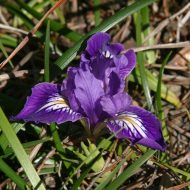Thompson’s iris –Iris thompsonii
Range: Lower regions in the Klamath Range of Del Norte County in northwestern California and southwestern Oregon, 300 to 2000 ft (90 to 600 m) elevation.
Original collection: Douglas Park on the Smith River, Del Norte County, California, by J.W. Thompson, 1928.
Name: By Robert C. Foster, 1936, for J.W. Thompson.

Key identifying features:
- Floral tube slender, funnel-shaped at top, medium length (around ¾ inch).
- Spathes short, broad and closed around ovary.
- Ovary triangular in cross section.
- Flower parts rather broad and rounded.
- Numerous flowers on each mature clump.
- Leaves very slender, grass-like, dark glossy green above, lighter matte below, long-lasting.
- Mature plants form dense, compact evergreen tussocks.
Flower color: Pale lavender to violet purple, occasionally white or gray.
Habitat: Open hillsides, sunny meadows or other exposed sites on lightly shaded slopes; fir / pine forests; well-drained soil.
Comments: Thompson’s iris was originally considered a variable hybrid population – the product of repeated crosses betweenIris innominata andIris douglasiana. Prof. Carol Wilson’s research indicates that comparisons of these three species does not indicate a hybrid origin forIris thompsonii.

